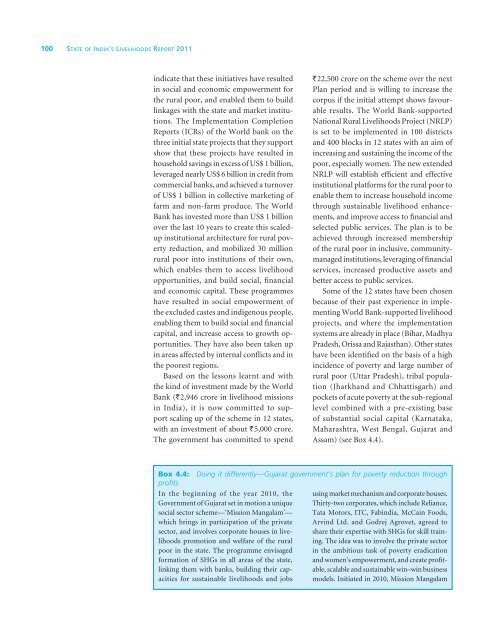SOIL Report 2011 - ACCESS Development Services
SOIL Report 2011 - ACCESS Development Services
SOIL Report 2011 - ACCESS Development Services
- No tags were found...
You also want an ePaper? Increase the reach of your titles
YUMPU automatically turns print PDFs into web optimized ePapers that Google loves.
100 State of India’s Livelihoods <strong>Report</strong> <strong>2011</strong>indicate that these initiatives have resultedin social and economic empowerment forthe rural poor, and enabled them to buildlinkages with the state and market institutions.The Implementation Completion<strong>Report</strong>s (ICRs) of the World bank on thethree initial state projects that they supportshow that these projects have resulted inhousehold savings in excess of US$ 1 billion,leveraged nearly US$ 6 billion in credit fromcommercial banks, and achieved a turnoverof US$ 1 billion in collective marketing offarm and non-farm produce. The WorldBank has invested more than US$ 1 billionover the last 10 years to create this scaledupinstitutional architecture for rural povertyreduction, and mobilized 30 millionrural poor into institutions of their own,which enables them to access livelihoodopportunities, and build social, financialand economic capital. These programmeshave resulted in social empowerment ofthe excluded castes and indigenous people,enabling them to build social and financialcapital, and increase access to growth opportunities.They have also been taken upin areas affected by internal conflicts and inthe poorest regions.Based on the lessons learnt and withthe kind of investment made by the WorldBank (`2,946 crore in livelihood missionsin India), it is now committed to supportscaling up of the scheme in 12 states,with an investment of about `5,000 crore.The government has committed to spend`22,500 crore on the scheme over the nextPlan period and is willing to increase thecorpus if the initial attempt shows favourableresults. The World Bank-supportedNational Rural Livelihoods Project (NRLP)is set to be implemented in 100 districtsand 400 blocks in 12 states with an aim ofincreasing and sustaining the income of thepoor, especially women. The new extendedNRLP will establish efficient and effectiveinstitutional platforms for the rural poor toenable them to increase household incomethrough sustainable livelihood enhancements,and improve access to financial andselected public services. The plan is to beachieved through increased membershipof the rural poor in inclusive, communitymanagedinstitutions, leveraging of financialservices, increased productive assets andbetter access to public services.Some of the 12 states have been chosenbecause of their past experience in implementingWorld Bank-supported livelihoodprojects, and where the implementationsystems are already in place (Bihar, MadhyaPradesh, Orissa and Rajasthan). Other stateshave been identified on the basis of a highincidence of poverty and large number ofrural poor (Uttar Pradesh), tribal population(Jharkhand and Chhattisgarh) andpockets of acute poverty at the sub-regionallevel combined with a pre-existing baseof substantial social capital (Karnataka,Maharashtra, West Bengal, Gujarat andAssam) (see Box 4.4).Box 4.4: Doing it differently—Gujarat government’s plan for poverty reduction throughprofitsIn the beginning of the year 2010, theGovernment of Gujarat set in motion a uniquesocial sector scheme—‘Mission Mangalam’—which brings in participation of the privatesector, and involves corporate houses in livelihoodspromotion and welfare of the ruralpoor in the state. The programme envisagedformation of SHGs in all areas of the state,linking them with banks, building their capacitiesfor sustainable livelihoods and jobsusing market mechanism and corporate houses.Thirty-two corporates, which include Reliance,Tata Motors, ITC, Fabindia, McCain Foods,Arvind Ltd. and Godrej Agrovet, agreed toshare their expertise with SHGs for skill training.The idea was to involve the private sectorin the ambitious task of poverty eradicationand women’s empowerment, and create profitable,scalable and sustainable win–win businessmodels. Initiated in 2010, Mission Mangalam














